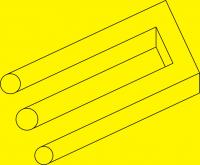Motor won't step at low jog rate
- Knas
- Offline
- New Member
-

- Posts: 13
- Thank you received: 0
I'm using a Gecko G540 and four Nema 23 380oz motors, the Y axis is driven by two motors (Y and A) and i just doubled the Y step/direction on the A pins for the dual motor control.
Please Log in or Create an account to join the conversation.
- BigJohnT
-

- Offline
- Administrator
-

- Posts: 7000
- Thank you received: 1176
Have you swapped A and Y to verify the problem is not with the drive?
JT
Please Log in or Create an account to join the conversation.
- Knas
- Offline
- New Member
-

- Posts: 13
- Thank you received: 0
I tested swapping Y and A - the problem is with the A driver quite clearly and not the motor. Again, it works perfectly with Mach3 so the hardware is not the issue (i just reverfied it).
I couldnt' really find much info on how to configure my machine (a KRMx02) so i did some research and came up with the following (which may or may not be entirely right):
I've set it up as a XYZ axis machine and used the "Gecko G540) driver type as the driver timing seconds - any chance this template is whacky? I've done the jitter tests and abused my computer.
Parallel port setup: (for the G540)
2 - X Step
3 - X Direction (inv)
4 - Y Step
5 - Y Direction (inv)
6 - Z Step
7 - Z Direction
8 - Y Step
9 - Y Direction
16 - Charge Pump
Axis setup:
Steps per rev: 200
Microstepping: 10
Pully teeth: 3:1
Leadscrew pitch: 2.8647
Max velocity: 15 in/s
Max acceleration: 30 in/s2
Same settings for all axises except Z that has a leadscrew pitch of 6.
Many thanks for any insight!
Please Log in or Create an account to join the conversation.
- Rick G
-

- Offline
- Junior Member
-

- Posts: 26
- Thank you received: 155
Are you saying that you are using the same parallel port pin to drive both Y axis?
If so I wonder if it could be a low voltage problem on the parallel port.
What mode is your parallel port in? It can some times make a small difference in the output.
You could also move the second Y driver to a different parallel port pin and just combine them in you hal configuration file.
Also double check your cable connection.
Rick G
Please Log in or Create an account to join the conversation.
- BigJohnT
-

- Offline
- Administrator
-

- Posts: 7000
- Thank you received: 1176
Its been found that 1 usec is marginal on the G540s
(not surprising as its the specified minimum width)
I think the latest pncconf uses 2 usec steplen 2 usec stepspace, 700 ns dir setup and 700 ns dir hold
for G540s . This gets you to the G540s specified maximum 250 KHz step rate but with
at least 500 nsec timing margins everywhere.
125 KHz is still 3750 RPM with a Gecko so probably plenty of margin for practical systems
Also note that the charge pump on the G540 will only work if the parallel port is in EPP mode. Some parallel ports won't do that.
JT
Please Log in or Create an account to join the conversation.
- Knas
- Offline
- New Member
-

- Posts: 13
- Thank you received: 0
I will def. test the other step settings for the Gecko and report back.
What really weirds me out is that the problem doesn't happen until 10 minutes and that it's not always the same response; some times the motor doesn't turn at all, some times it just has a time-delay.
Please Log in or Create an account to join the conversation.
- Rick G
-

- Offline
- Junior Member
-

- Posts: 26
- Thank you received: 155
Please Log in or Create an account to join the conversation.
- Knas
- Offline
- New Member
-

- Posts: 13
- Thank you received: 0
I'm trying to look into how to configure this as a true XYYZ axis machine with HAL, maybe that will help.
Please Log in or Create an account to join the conversation.
- Knas
- Offline
- New Member
-

- Posts: 13
- Thank you received: 0
[TRAJ]
AXES = 4
COORDINATES = X Y Z Y
and in the HAL:
loadrt gantrykins coordinates=xyzy
setp gantrykins.joint-0 0
setp gantrykins.joint-1 1
setp gantrykins.joint-2 2
setp gantrykins.joint-3 1
Please Log in or Create an account to join the conversation.
- Rick G
-

- Offline
- Junior Member
-

- Posts: 26
- Thank you received: 155
if you are running steppers with two axis that are the same and you are not going to install separate home or limit switches you can just output the step signals to two sets of parallel port pins. Just use the standard XYZ setup and something like this...
x axis
net xdir => parport.0.pin-04-out
setp parport.0.pin-05-out-invert 1
net xstep => parport.0.pin-05-out
setp parport.0.pin-05-out-reset 1
slave axis
setp parport.0-08-out-invert 1
net xdir => parport.0.pin-08-out
setp parport.0.pin-09-out-invert 1
net xstep => parport.0.pin-09-out
setp parport.0.pin-09-out-reset 1
That should be close but from memory. The one is reversed here because if you had two motors at opposite sides and they both pointed inward a move would be with one clockwise and the other counter clockwise, but it is easy to switch.
If you go this route you do not need gantrykins
Rick G
Please Log in or Create an account to join the conversation.
